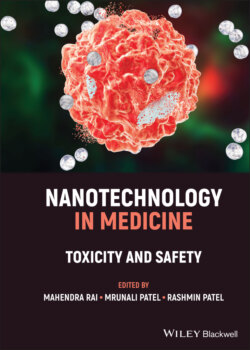Читать книгу Nanotechnology in Medicine - Группа авторов - Страница 23
На сайте Литреса книга снята с продажи.
1.7 Conclusion and Future Perspectives
ОглавлениеNanomedicine has raised exhilarating prospects for many medical issues. It has contributed, both basic and translational, to several major developments. Many of these developments have been made in the area of diagnosing and treating cancer. Study focuses are extending to other medical issues such as antibiotic resistance, cardiovascular problems, and artificial organs. Due to the simplicity of design, researchers believe, nanomaterial platform design is likely to be of benefit in these fields too. However, technical questions have arisen due to the lack of information about the behavior of nanomaterials inside living organisms. Conversely, relatively little is already understood about the ability of nanomaterial to induce adverse effects or humoral immune responses until they are accidentally or purposely inserted into the organism. The biggest concern with their use in medicine is the possible toxicity of NPs. The toxicity of NPs highly depends on the core and shell's nature, size, electrical charge, and chemical composition. As nanomaterial production grows, nanotoxicology and nanorisk have drawn growing interest from toxicologists and regulatory scientists. Nanotoxicology focuses on uncovering the mechanistic relationship between physicochemical characteristics of the NPs and the subsequent biological effect. Besides, it aims to refine the experimental conditions for in vitro and in vivo evaluation to identify the potential interaction of NPs with various assays and to provide evidence for the safety assessment of this nanomaterial and its applications. Though, the shortage of uniform assays and preset regulations have made it difficult to associate with the existing literature about their safety. The science community has endured comprehensive debates over two decades and still has not come to a common ground on NPs’ metrics, definitions, classifications, attributes, safety/toxicity characteristics, endpoints of toxicity, target endpoints, thresholds of occupational/environmental risk, and systematic methods of assessment. In attempts to bridge international harmonization and standardization, both government and nongovernment organizations are collaborating to resolve the regulatory challenges. In addition, there are currently no specific processes and regulatory standards available for the assessment or testing of nanomaterials.
“Smart” nanomedicine demands step‐by‐step quality testing as an integral part of all new nanoformulations. A range of methods to design NPs with reduced toxicity are now possible relative to conventional NPs. In order to improve the chances of clinical translation, adherence to the good clinical practice standards is expected from phase I to closely supervised phase IV. However, the most significant challenge faced today in the field of nanotoxicology is the detection and evaluation of the adverse effects of a variety of engineered nanomaterials that are commonly manufactured and launched for versatile applications with their different physicochemical properties. Because of multiple reasons, for example, the precise hazard distinctions of NPs are not quite easy to discover, we are not clear about the physicochemical property of the NPs affecting the toxicity, although, the extreme improvements in molecular, chemical, and other properties that can be formulated by nanotechnology applications are so fascinating that analysis can even be valued to assess their effects on product quality, potency, or other functionality. Also, advanced techniques and approaches are required for the study of NPs’ toxicity making it possible to examine, at the molecular level, multiple processes and mechanisms of toxicity and to accurately predict possible harmful effects at the level of the body. There is a need for autonomous sources like public finance organizations and foundations to back up the research needs of maturing nanodrugs. In addition to concerns relating to nanomaterials and the complexity of biological processes, there are issues relating to the putting of the substance on the market, including large‐scale processing, biocompatibility, intellectual property issues, regulatory issues, and general cost‐effectiveness relative to conventional treatments. Nevertheless, there is still tremendous hope and we remain optimistic that nanomedicine will certainly take its place not as a miracle cure but as a solution to unique, unmet patient needs in clinical practice.
